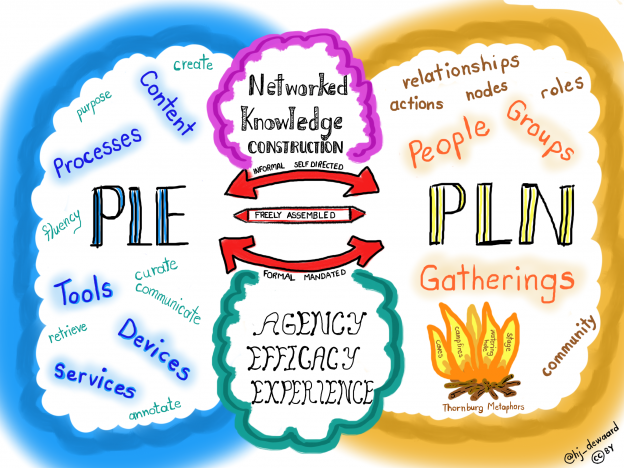Produsage is Palimpsestic
I’ve finished reading two articles:
- Produsage: Towards a broader framework for user-led content creation
- Teachers as connected professionals: A model to support professional learning through personal learning networks.
These two articles provide interesting frameworks with an integration of agentic action within emergent, collaborative, knowledge-constructive, self-organizing networks. One idea that strikes me, as I compare and contrast these frameworks, is how teacher educators and the students in their classrooms, the preservice teachers, need to become deeply aware of these produsage tendencies within openly shared, iterative, and palimpsestic landscapes.
Palimpsest, meaning ‘scraped again’ and ‘revolve, move around’ (Online Etymology Dictionary) is the tendency to reuse and overlay new content within the materials of previous versions. It is also described as an object or location that contains “diverse layers or aspects apparent beneath the surface” (Merriam Webster Online Dictionary). It is a conceptualization born in a time of scarcity, when writing materials such as paper were in short supply and were often reused for new works. In geographic terms, it’s a re-creation of landscapes with a human cultural or geologic interface as seen in this Canadian Geography article. In terms of digital environments where content, as the product of learning, is layered and apparent within facets of professional, personal, collaborative, knowledge-building networks created by ‘prod-users’ of education.
Bruns (2007) describes characteristics of produsage:
- broad based content creation within wide communities of participants
- fluid movement between roles, both amateur and professional (which remind me of the fluidity found in the concept of affinity spaces)
- artefacts that are continually iterated and evolutionary
- “permissive regimes of engagement” (para.12); based on merit rather than ownership, enabling continuous collaboration to improve content (which reminds me of the Creative Commons certification process which iterates as it teaches, with content being continually updated and artefacts continually produced).
While there are some models of this form of produsage available, they are not fully formed or easily found – the eCampus Ontario Extend – Activity Bank is one that comes to mind. Another is the OERCommons that is building a repository of content created by producers of knowledge that shifts beyond traditional value-chain, consumeristic models. Brun (2007) elaborates on how commercialization impacts the often unpaid labour of produsers through harnessing the hive, harvesting the hive, harbouring the hive, or hijacking the hive. Each of these approaches can be seen in the ever-present ed tech industry’s engagement with educators in open and closed teaching and learning spaces.
Oddone, Hughes, and Lupton (2019) explore how teachers use, create, and engage in personal and professional learning networks in their multiple case study analysis of PLNs. In palimpsestic terms, this research is building on PLN explorations with educators while structuring a new framework that describes the layering of PLNs using a linking, stretching, and amplifying lens. This article is interesting in how the lens informs the practices of teachers in connecting, networking, and collaborating. Oddone et al. (2019) describe learning arenas (pedagogical, personal, and public), teacher as learner (autonomous, participatory, networked, and social network literate), and the PLN (social technologies and network of diverse connections). Each of these layers can be peeled back to examine what lies between, as Oddone et al. (2019) do with quotes from their participants. These researchers conclude that PLNs provide a model for professional learning that values “flexible, mobile, and highly relevant” digitally mediated contexts (p. 115).
Bringing these two articles together provides a model of produsage in teacher professional learning networks that layers experiences, topics, content and artefacts into the learning done by teachers around the globe. How then can these be harnessed, harboured, and honoured before they become monetized, harvested, and hijacked by those without consideration to the labour and love of learning exhibited by those who openly share in the field of education.
References
Bruns, A. (2007). Produsage: Towards a broader framework for user-led content creation. Creativity & Cognition, 6. Retrieved from http://produsage.org/files/Produsage%20(Creativity%20and%20Cognition%202007).pdf.
Oddone, K., Hughes, H., & Lupton, M. (2019). Teachers as connected professionals: A model to support professional learning through personal learning networks. International Review of Research in Open and Distributed Learning, 20(3). https://doi.org/10.19173/irrodl.v20i4.4082
